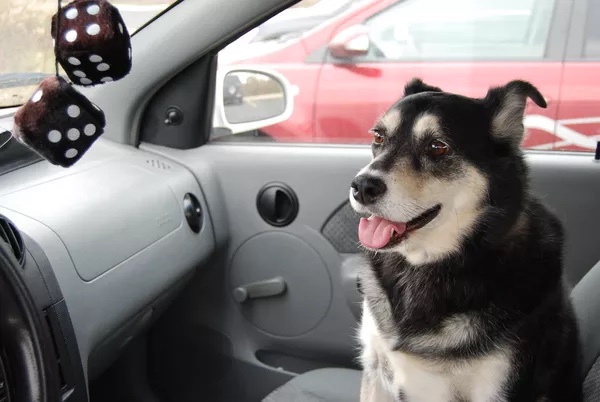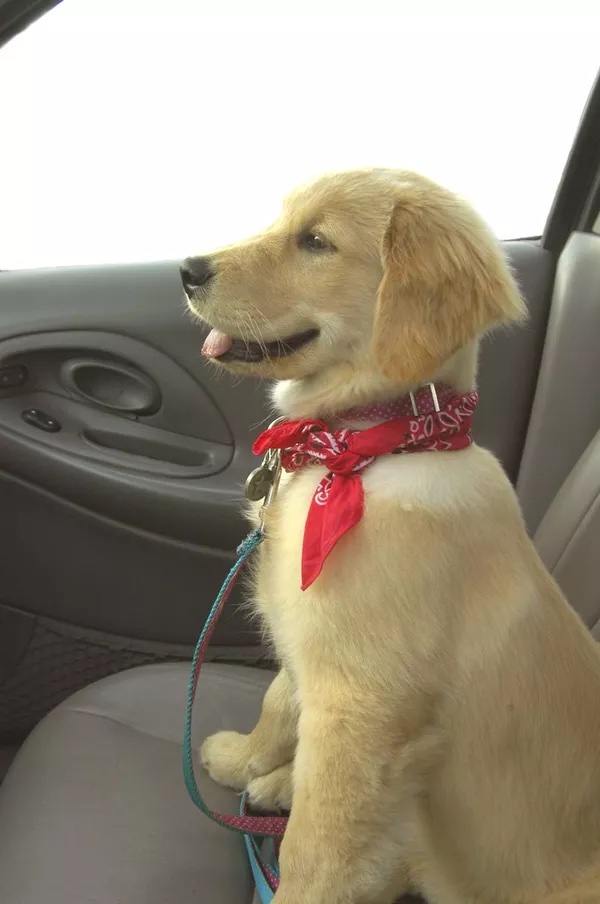by Zan Raynor, certified dog trainer and CEO of ELLAS Animals INC
Motion sickness in dogs, just like in people, is quite common. Also just like in people, motion sickness tends to be more common in puppies (or children) than in adults. So the good news is that most dogs will outgrow their motion sickness and traveling with them will be more pleasant for the people as well as for the dogs.
Causes of Motion Sickness in Dogs
Motion sickness in dogs has two main causes – physiological and psychological. It’s completely possible that your dog isn’t actually experiencing motion sickness as much as stress or anxiety about riding in the car. It’s also possible that your dog isn’t stressed at all but genuinely just feels terrible when riding in the car. There’s even the crossover – it’s possible that your dog feels so miserable riding in the car that they’re developed stress and anxiety about riding in the car. Puppies can develop anxiety about something after only one bad experience with it!
Psychological
One of the reasons dogs develop anxiety about riding in cars is where they go in the car. Some dogs only ride in the car when they’re going to the veterinarian, where scary and unpleasant things happen to them, so they associate riding in the car with the vet visit. Puppies in particular experience this because they go to the vet every few weeks for more shots and they don’t go to a lot of other places during that time because they aren’t yet fully vaccinated so they are quick to make the association. Dogs can also have anxiety about car rides because they’ve gotten hurt (getting in or out or slamming around during the drive). Perhaps they’ve been left in the car and were hot/cold or lonely/scared. Perhaps the engine noise scares them or the motion makes them feel unsafe.

Physiological
The most common physiological reason for motion sickness in dogs is because their inner ear balance is not fully developed. This will develop fully for most dogs by the time they’re a year old. However, it’s worth noting that dogs can also experience motion sickness from middle or inner ear infections or even vestibular disease so it’s worth a trip to the vet to check it out if your dog is showing signs of motion sickness. There are also some medications that dogs might be on which can increase their tendency to vomit or have diarrhea and the vet can review this at that time.
Signs of Motion Sickness in Dogs
The signs of motion sickness in dogs are often the same whether the cause is physiological or psychological, but not all dogs will show all the symptoms. Obviously, if your dog is vomiting or having diarrhea, that’s a pretty good sign that they’re experiencing motion sickness, but here are a few others:
- whining, crying, moaning, barking
- excessive drooling or panting
- licking or smacking lips
- pacing
- being lethargic or particularly inactive

Management Techniques for Motion Sickness in Dogs
Before we get to the more time-consuming training part, let’s talk about a few management tips that can provide some relief more quickly. Management are things you can do to set your dog up for success, or at least to avoid failure or misery/discomfort, without any active dog training on your part.
First, keep the car cool and reasonably quiet and your driving smooth. Hot and muggy is likely to upset a dog’s stomach just like a human’s. Also, loud and hectic environments are likely to raise your dog’s tension and therefore increase their motion sickness. Try to convince the kids to keep the crazy train quiet for a bit. Perhaps play some quiet classical music but avoid blaring the rock music. Choose a car where the muffler isn’t turning heads on the street or rumbling the whole car. In fact, if your dog acts more scared of one car than another, choose the car that upsets your dog less, whether that has something to do with the car itself or if it’s just some trauma about where they went in a particular car. Drive smoothly without sudden jerking stops or turns. Try to avoid twisty roads and tight circles.
Second, open a window, even if only a couple inches. Although we can all appreciate the joyful abandon of a dog with their full head and torso hanging out the window, their jowls flapping madly in the wind while their ears dance around like flags, this much fresh air isn’t necessary to help overcome motion sickness in a dog. Even a couple inches gives some fresh air movement to calm the senses and some interesting scents to distract from their misery. It also helps balance the air pressure between the outside and the inside and this can help with inner ear issues as well.
Third, prepare for the trip by planning meals around travel times. You want your dog to travel on an empty stomach so make sure you’ve fed your dog at least three hours prior to any car rides. However, keep fresh water on hand because this actually helps settle a dog’s stomach.
Fourth, wherever/however you have your dog ride in a car to keep them (and the driver and passengers) safe, try to arrange things so they can see out the front window. A dog who’s down in the bottom of the car or who’s looking out the side windows at the scenery whizzing past will be more likely to have inner ear issues that make them sick.

Finally, if you sense that your dog is getting miserable or is about to vomit, pull over and take a break. Let the dog get out of the car (on their leash) and walk around a bit, allowing them to sniff. Getting out of the moving car and moving around will settle the inner ear balance, and sniffing gets them fresh air and distracting, stomach-settling smells. The additional benefit is that if they do vomit, they’ll do so outside of your car! Periodic breaks like this can help you get through longer drives if you can’t avoid them until your dog can handle them without the misery.

Desensitization and Counterconditioning for Motion Sickness in Dogs
Now let’s talk about active training – desensitization and counterconditioning.
Desensitization means gradually increasing exposure to a situation or stimulus (trigger) at a level so low that there is no negative response. Basically, this means getting your dog used to something slowly and gently, a little bit at a time. Counterconditioning means changing your dog’s emotional response to a situation or stimulus by pairing that situation or stimulus with something fantastic. This means even when the dog sees something that scares them, they think, “Ooooh, that means I’m getting a treat!”
If the motion sickness in dogs is physiological, desensitization can gradually make your dog more comfortable while they’re developing and growing out of motion sickness. If the cause is psychological (even if the psychological response is caused by physical discomfort), the combination of desensitization and counterconditioning can “reprogram” the dog’s reaction to car rides.
Desensitization
Threshold
The first step of desensitization training is finding the dog’s threshold. This is the point at which they begin to get agitated. It may be that your dog starts pulling backward on the leash, lying down, refusing to walk toward the car as soon as you’re out the door on your way to the car. However, it’s possible your dog doesn’t start getting tense until you try to get them into the car, or maybe not even until they’re in the car or until you start the engine. Observing your dog carefully while going through your get-in-the-car routine will help you identify the precise point where your dog starts displaying signs of stress. One step back from that, before the signs of stress appeared, is your dog’s threshold. That’s your starting point for desensitization training – right before your dog gets tense, while they’re still calm. The basic idea is to repeat exposure at this level until you can move just a bit closer, just a bit further along in your get-in-the-car routine without the dog getting tense. If you go too far or too fast, just back up and slow down and repeat exposure on the comfortable side of the threshold for a bit.
Gradually Increasing Exposure
Breaking this down into incremental steps may help you watch for your dog’s threshold and step forward slowly. You may not have to do this whole process. You’ll pick up this process wherever your dog’s threshold is and go from there.
Walk By
Start off by walking with your dog out of the house and past the car without stopping or slowing down (if you slow down, the dog might think you’re getting in it). If your dog gets tense, you’ll need to walk farther away from your car. Test it out and see how far away you need to be from the car for the dog to walk past it like it’s no big deal.
Opening Doors
When your dog can walk past the car without displaying stress, slow down and maybe even stop by the car. When your dog can do this without stress, open a door (but don’t get in). Close the door and walk away. When your dog can do this without stress, have the dog get in the car (but don’t close the door and don’t get in yourself). Let the dog get right back out again. Note: If the dog won’t get in the car, don’t force it. Repeat the exposure of stopping at the car a few more times and try again, but ask for something less, like just putting their front paws on the seat or just sniffing the inside of the car. Praise this behavior (you can give them a treat) but move on. Don’t pressure them to get all the way in until they do it willingly.
Turning Engine On
When your dog can get in the car without stress, just sit there a bit. Don’t turn on the engine or drive anywhere. Do this several times so that your dog knows that sometimes you just sit in the car and then get back out again. When the dog can sit in the car for a few minutes without stress, you can turn the engine on and off and then get out of the car. Gradually, you can lengthen the amount of time you spend sitting in the car with the engine on before getting back out with your dog.
Short Drives
When your dog can sit in the car with the engine on, not moving, without stress, begin your movement stage by just pulling forward and then backward in your driveway, and get out of the car. When your dog is comfortable with this, you can try driving around the block and then parking at home again and getting out of the car. At this point, you can start taking short trips, like 5 minutes. As you see that your dog is fine, you can gradually extend these trips to 10, 15, and 20 minutes. Early in this process, keep your speeds slow and progress to faster speeds on busier roads gradually. With all of the other management tips, you’re on your way to traveling wherever you need to go with your dog.
Counterconditioning
To countercondition your dog, you need to create an association in your dog’s mind between car rides and good things. A simple way to do this is to
- Have some favorite toys that only get played with in the car.
- Be sure that the destination is desirable to the dog. Not only does this mean making sure that car rides end at the vet or groomer only 10% (or even 1%!) of the time, but also that the car ride isn’t just a round trip. Stop at a friend’s house where they like the person and/or their animals. Stop at a park and play games with your dog. Stop anywhere to let the dog sniff and explore (on leash). Note: Petsmart or places like that may sound like a fun place for dogs to you, but dogs often find them stressful and overwhelming. That isn’t necessarily a fun place that will help with counterconditioning.
- Reward with lots of praise and snuggles and limited treats. Be careful not to fill the dog up with treats that will just come right back up or make them feel nauseated. Choose some small ones that are enjoyable but don’t load the dog up. You can bring favorite blankets that smell like home or their bed/crate.
- Talk to your dog in a gentle and happy voice. Pet your dog. You can even try singing gentle, happy songs. Reassure your dog that this is a happy place.
- If your dog shows more anxiety with a particular vehicle, start with a different vehicle and build happy associations and then transfer those to the more problematic car later.
- Avoid correcting your dog, yelling at your dog, punishing your dog, or anything that will develop negative associations with car rides for your dog.

Medications for Motion Sickness in Dogs
If your dog’s motion sickness is physical, it may take time for their inner ears to fully develop (and in rare cases a dog may suffer from motion sickness throughout their lives). During what could be a long first year, all of these management and training techniques are still good practice. However, it’s possible you and your dog may benefit from talking to your veterinarian about medications to decrease nausea and/or calm your dog’s nerves. Whether your dog’s issues are physiological, psychological, or both, you’ll want to decrease the stress on both of you by being open to remedies your veterinarian recommends as safe and effective.
As you experiment and observe your dog, you may find a good combination of techniques to get you through the immediate rough patch and to develop a lifelong love of car rides that can make your dog one of your best traveling companions for adventures and errands alike. Check out ELLAS Animals INC’s online courses so you and your dog can enjoy yourselves once you’re there!

Nothing in ELLAS Animals INC’s website or blog is intended as medical, legal, or financial advice. We receive no compensation for recommendations or reviews.
